Performance
Consecutive
and spontaneous read/write process
We use Anvil's Storage Utilities 1.0.51 to
measure the spontaneous and consecutive write speed. The synthetic base point
integrated onto this software provides an excellent overall review about the
products by experimentally check a series of particular speeds of the testing SSD.
The result which you see here refers to the
SSD FOB (fresh out-of-box) non-degraded efficiency. Moreover, we use non-compressed
data, which is the most favorable scenario for the SF-2281 LSI controller using
on-the-fly data compression. However, our tests show that in the present world
where the data can only partially compressed and the used flash memory has high
speed and syncing interface, the compressing algorithms don’t have any effect
on the actual working efficiency of the SSD with SandForce controller. So, we renounce
the idea of testing the SandForce SSD based on the compressed data: these
results will be exclusively multiplied in nature and there will be no real-time
value for us today.
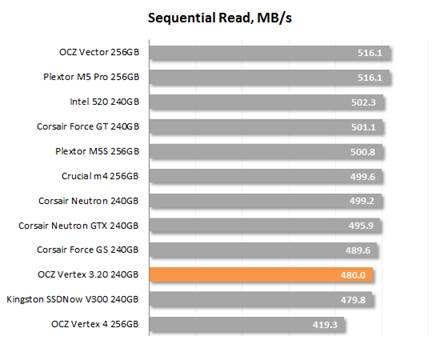
Consecutive
read process
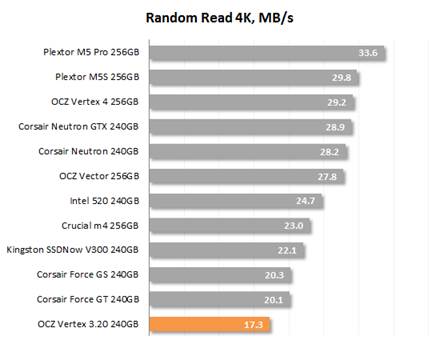
Random
Read 4K
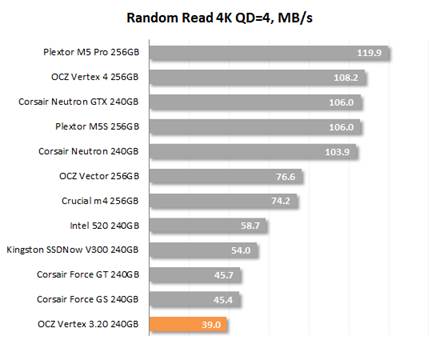
Random
Read 4K QD=4
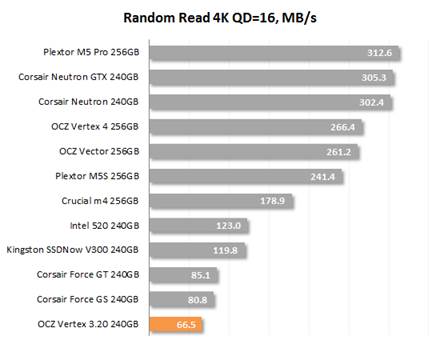
Random
Read 4K QD=16
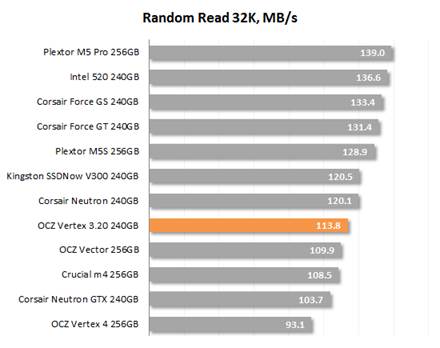
Random
Read 32K

Random
Read 128K
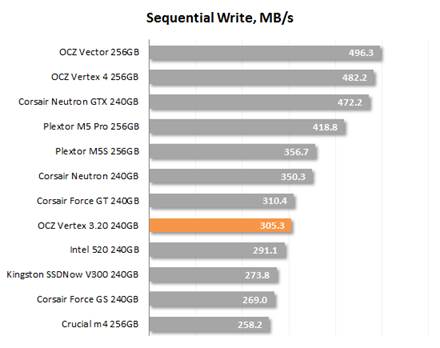
Consecutive
write process
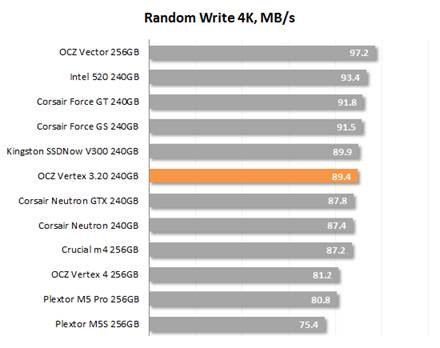
Random
Write 4K
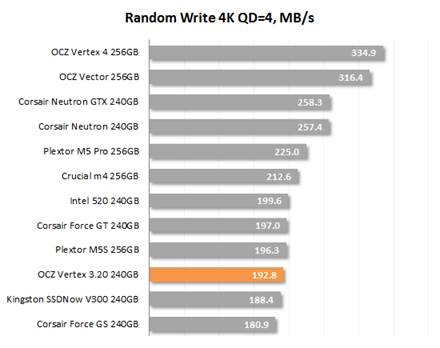
Random
Write 4K QD=4

Random
Write 4K QD=16
But improvement doesn’t rest and the
results on the diagram are an excellent illustration for this fact. We reviewed
SandForce-platform SSDs as high-efficiency products just one year ago and now
they don’t deserve that position. Based on the platform introduced last year,
the new generations of SSD is ahead of the SF-2281-platform solution.
Currently, one SandForce-platform SSD can only desire to become a decisive
product without discrimination about what its flash memory can contain.
Meanwhile, Kingston SSDNow V300 is not a
typical representative for this product segment. It tells apart from the better
models from most of SandForce-platform SSD, almost appropriate to the
efficiency of the Intel 520 processor which does a better job than its partners
thanks to its exclusive software. The custom software from Kingston and LSI beneficial
to the last users is obvious, making SSDNow V300 not one of the fastest SandForce-platform
solutions. Interestingly, it’s faster than the more-expensive Kingston HyperX
3K (the same to Corsair Force GT) because the latter models use the typical
hardware components as well as original software.
Performance
Degradation, Garbage Collection and TRIM
Unfortunately, the SSD doesn’t always
work as fast as in their "fresh" status. In many cases their speed
reduces after a while and in actual using process, we will challenge with write
speeds which are completely different from what we see on the diagram in the
previous chapters in our review. The reason for this phenomenon is as follows:
because SSD is out of empty pages in flash memory, its controller has to
erase the memory page block before saving data into them, causing noticeable
delay. Therefore, the current SSD normally tries to free the memory ahead, and the
saving process is not performing at any time. This process normally happens in
idle mode. At this .moment the SSD controller can reduce almost completely the
performance drop by erasing the flash memory pages which is used ahead of time.
the correlative steps are normally be performed in idle mode, when the
controller can completely be recovered in its SSD efficiency by erasing the
unused flash memory pages. They use 2 techniques for this process, which is:
garbage can in idle time and TRIM.
A SSD controller doesn’t know what memory
pages contain user data, and the pages are considered to be empty by the OS. It
will happen in that way because in the system the files will perform the
process of removing a file that is unrelated to its actual physical removal.
Instead of that, the correlative memory highlighted in the file system is
available for writing data in. so, there’s nothing related to the OS, a SSD controller
can only pre-erase the pages in the storage pool (if any), which is
inaccessible by the OS. For a better solution for this problem, the modern OS
has TRIM command which helps to improve efficient garbage collection. TRIM provides
SSD controller with the info in which the data is capable of being removable
without causing any damage, as it’s considered unusable by the OS. As a result,
the SSD controller can increase the pages erased by the physical unneeded-data
removing process so that users can’t feel a performance drop during the next
writing time.
This is the way it will sit in the ideal
conditions. However, in fact, the SSDs are different in their garbage
collecting process and perform TRIM. That’s the reason why we check the performance
reduction of a SSD when changing from the state of being taken out of its box (the
flash memory is clean) to stable state. This test follows the SNIA SSSI TWG PTS
instruction, which means that we measure the writing speed in 4 cases one by
one. First we measure the SSD "fresh" speed. Then we measure the
speed after SSD is full-loaded with data twice. The 3rd testing
version happens right after a 30min break in which the controller can somehow
be restored in its operation by running garbage-collector during the break. And
finally, we measure the speed after emitting a TRIM command.
We run the tests in the standard synthetic
IOMeter 1.1.0 RC1, where we measure the radom writing speed when working with
the 4 KB data block being suitable for the flash memory page at 32 serial
requests. The testing data is fake-random. The following diagrams show the
history of the relative speed changes, in which 100% refers to the SSD efficiency
in “fresh-out-of-box” state.
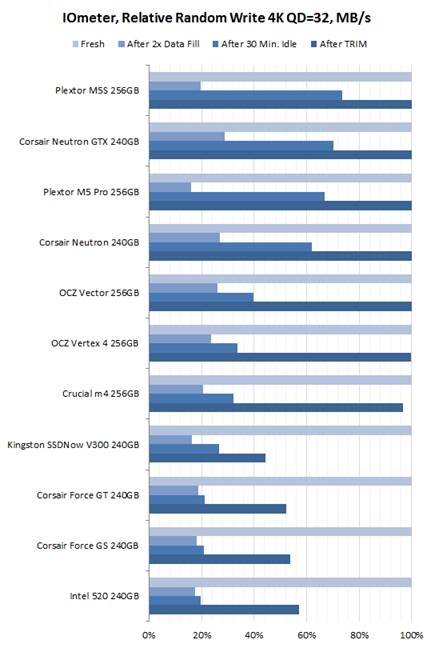
Iometer,
Relative Random Write
As you can see in the diagram, the
efficiency-reduction issue only exists on the SandForce-platform SSD. Other
models can restore their speed to the starting point after a TRIM command being
implemented. That’s the reason why Kingston SSDNow V300, like all of the other
SF-2281-platform solution, is more suitable for a system drive, not for saving
user data. When the file is rewritten continuously, text implementation of SSD can
reduce significantly by half, which is the most annoying thing.
The background garbage-collecting app
doesn’t work well on the SandForce-based platform SSDs. Though they have a large
reserve position, their speed can only be recover, even a part, in the TRIM-supported
environment. This comment is important for Windows XP (where TRIM is not
supported at all products), allows Mac OS X OS (when you have to allow TRIM), and
for the RAIDs OS (where TRIM depends on the control driver of the RAID
controller).